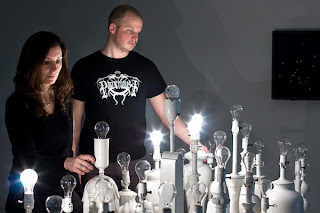 |
| darkSky |
 |
| Watch the fireflies on the monitor when all the lights are off. |
Another important aspect of this piece is the individual choice of whether or not to have the installation consume large or small quantities of electricity; this personal choice encourages the visitor to think for themselves about the impact their actions have on energy consumption, and in turn the greater environment. For this reason, art plays a crucial role in our sustainable future, for it allows all people, even those who do not believe in climate change, to look and interact with environmental reality from a different angle. Interactive and meaningful art like Holmes’ plants the seeds for a new era of understanding and personal responsibility of our resource consumption, just one step toward a post-carbon city life without fossil fuels, and with happiness and caring for our environment and each other. Breaking away from the so-called “meaningful art” plaguing the contemporary art world (what exactly is a stain on a piece of paper trying to tell me?), Holmes’s art redefines what successful contemporary art is today: a revealing interaction between an individual and ecological information greatly affecting our global society and environment for the better.
No comments:
Post a Comment